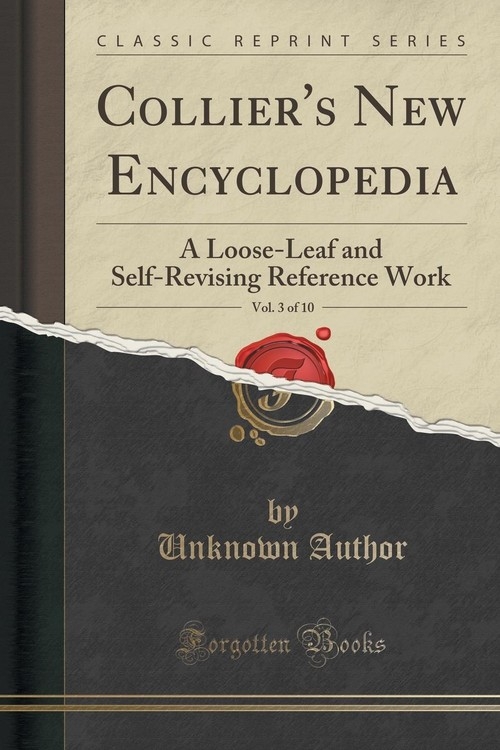Collier's New Encyclopedia, Vol. 3 of 10 A Loose-Leaf and Self-Revising Reference Work (Classic Reprint)
Author Unknown
Collier's New Encyclopedia, Vol. 3 of 10
A Loose-Leaf and Self-Revising Reference Work (Classic Reprint)
Author Unknown
- Wydawnictwo: FB &c Ltd
- EAN: 9781331289197
- Ilość stron: 582
- Format: 15.2x22.9cm
- Oprawa: Miękka
Niedostępna
Opis: Collier's New Encyclopedia, Vol. 3 of 10 - Author Unknown
Excerpt from Collier's New Encyclopedia, Vol. 3 of 10: A Loose-Leaf and Self-Revising Reference Work
Circumnavigator, one who sails round the globe. The first European known to have circumnavigated the globe was Magellan or Magalhaens, a Portuguese, who accomplished the feat in A. D. 1519. From him the Strait of Magellan derives its name.
Circus, among the Romans, a nearly oblong building without a roof, in which public chariot-races and exhibitions of pugilism and wrestling, etc., took place. It was rectangular, except that one short side formed a half-circle; and on both sides, and on the semicircular end, were the seats of the spectators, rising gradually one above another, like steps. On the outside the circus was surrounded with colonnades, galleries, shops, and public places. The largest of these buildings in Rome was the Circus Maximus, capable, according to Pliny, of containing 260,000, and according to Aurelius Victor 385,000 spectators. At present, however, but few vestiges of it remain, and the circus of Caracalla is in the best preservation. The games celebrated in these structures were known collectively by the name of ludi circenses, circensian games, or games of the circus, which under the emperors attained the greatest magnificence.
The modern circus is a place where horses and other animals are trained to perform tricks, and where exhibitons of acrobats and various pageantries, including a large amount of buffoonery, are presented.
Cirrhosis, a chronic nonsuppurative inflammation affecting the interstitial connection or supporting tissues of an organ. The process begins after a more or less hypermia of the parts in a growth of new connective tissue which is fibrous in character. This subsequently contracts, and in so doing interferes with the nutrition of the proper physiological tissue of the organ, causes it to atrophy or degenerate, and finally takes its place. The term was originally applied to the Liver (q. v.).
Cirrus (plural, Cirri), the tendril of a plant by means of which it climbs, usually a modified leaf or the prolongation of a midrib.
Cirrus. See Cloud.
Cirta, the capital of the ancient Massylii in Numidia. After the defeat of Jugurtha it passed into the hands of the Romans, and was restored by Constantine, who gave it his own name. See Constantine.
Cisalpine Republic, a former state in north Italy. After the battle of Lodi, in May, 1796, General Bonaparte proceeded to organize two states - one on the S. of the Po, the Cispadane Republic, and one on the N., the Transpadane. These two were on July 9, 1797, united into one under the title of the Cisalpine Republic, which embraced Lombardy, Mantua, Bergamo, Brescia, Cremona, Verona, and Rovigo, the duchy of Modena, the principalities of Massa and Cararra, and the three legations of Bologna, Ferrara, and the Romagna. The republic had a territory of more than 16,000 square miles, and a population of 3,500,000. Milan was the seat of the government or Directory. The army consisted of 20,000 French troops, paid by the republic. The republic was dissolved for a time in 1799 by the victories of the Russians and Austrians, but was restored by Bonaparte after the victory of Marengo, with some modifications of constitution and increase of territory. In 1802 it took the name of the Italian Republic, and chose Bonaparte for its president. A deputation from the republic in 1805 conferred on the Emperor Napoleon the title of King of Italy; after which it formed the kingdom of Italy till 1814.
Cisco, a city of Texas, in Eastland co., on the Texas and Pacific and the Texas Central railroads. It is the distributing center for a large territory. Its business is drawn largely from the oil industry. In 1920 a large dam to provide for the city's water supply was begun. It is the center of an important agricultural region and in the neighborhood are important clay and coal deposits. It has newspapers, elect
Szczegóły: Collier's New Encyclopedia, Vol. 3 of 10 - Author Unknown
Nazwa: Collier's New Encyclopedia, Vol. 3 of 10 A Loose-Leaf and Self-Revising Reference Work (Classic Reprint)
Autor: Author Unknown
Wydawnictwo: FB &c Ltd
Kod paskowy: 9781331289197
Języki: angielski
Ilość stron: 582
Format: 15.2x22.9cm
Oprawa: Miękka






























